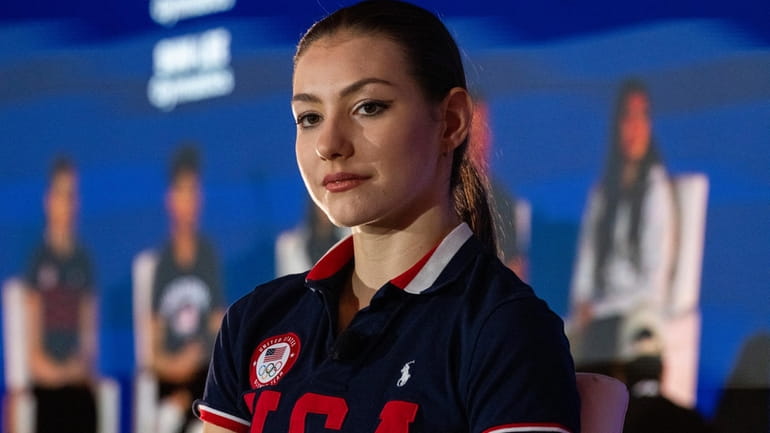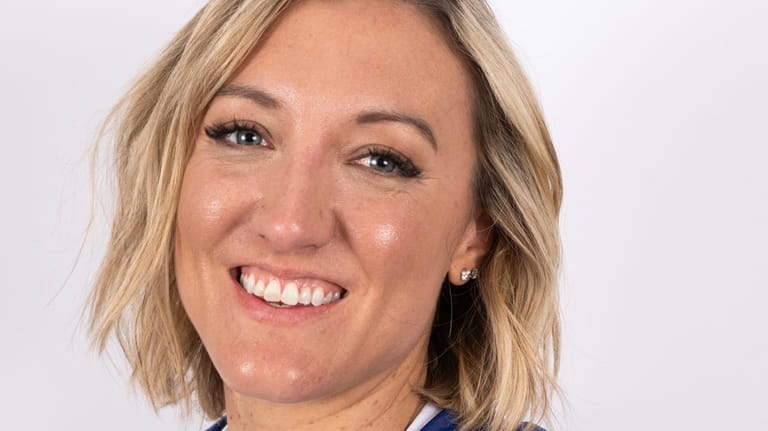Paris-bound Olympians look forward to a post-COVID Games with fans in the stands

Gymnast Evita Griskenas is shown during a press conference at the Team USA Media Summit Monday, April 15, 2024, in New York. Credit: AP/Brittainy Newman
NEW YORK — The biggest races, routines and games for many of this generation's Olympic athletes were contested in front of mostly empty stands, largely devoid of coaches to help them out or friends and family to cheer them on.
That was three years ago at the COVID-19 Summer Olympics and two years ago at the COVID-19 Winter Olympics. Now that they're preparing for the Paris Olympics that begin in July — and a return to something that feels normal — the Americans heading back to the Games know they can never take for granted the screaming fans and a hug from Mom or Dad.
“I think it's super important to be able to share these massive moments with people you care about," said BMX rider Alise Willoughby, who has been to the last three Olympics.
Willoughby and about 100 other U.S. athletes are doing interviews and photo shoots this week at the Team USA media summit at a hotel in Times Square — an event that itself was made impossible in the lead-up to the Tokyo Games in 2021 amid the coronavirus pandemic.
One topic of conversation this week is how grateful the bikers, rowers, gymnasts and the rest are to be past the days of contact tracing, quarantines and daily swabbing or spitting for COVID-19 tests inside the so-called Olympic bubble.
In Paris, there will be celebrations with relatives and one-on-one contact with coaches, most of whom were not allowed into the venues three years ago. The USA House — a traditional stop for athletes to wind down and kick back, especially after they're done competing — will be doing brisk business once again.
Mostly, athletes are looking forward to the chance to soak in the feeling from the crowd, an element sorely missing in the cavernous and largely unfilled venues in Tokyo.

Volleyball athlete Jordan Larson poses for a portrait at the Team USA Media Summit Monday, April 15, 2024, in New York. Credit: AP/Brittainy Newman
“I’ll be able to see the audience’s emotions. I want to build that with them and I can tailor my routines to that,” said American rhythmic gymnast Evita Griskenas, who plans French music to accompany one routine and “All-American” number for another, all with the goal of getting fans caught up in the moment.
Griskenas said she already feels a different vibe. Preparing for the Olympics in Tokyo — Games that were initially delayed by a year, then held in an atmosphere nobody quite recognized — became a largely solitary, and joyless, affair.
“It turned into training in my basement and throwing things outside," she said.
This year, a different experience awaits, and some athletes are even looking forward to a crowd rooting against them because, hey, at least it's a crowd.
“The boys have been saying, ‘We want to play France in, like, the semifinals,’” rugby player Perry Baker said. “You just visualize how big that can be, and how fun that can be. Their crowd. Our crowd. We live for those moments.”
With crowds, naturally, come other issues that were mostly set on the sideline in 2021. On Monday, French President Emmanuel Macron said the much-touted opening ceremony scheduled for the Seine River could be moved to the Stade de France if the security threat is deemed too high.
Asked what she thought of that possibility, Nicole Deal, the chief of security for the U.S. Olympic and Paralympic Committee, said other than her main goal — athlete safety — she wants to provide the best experience for the athletes.
“Security is an underpinning and a foundation. We’re not the main show,” Deal said.
With two of the next five Olympics set to come to the U.S. — Los Angeles hosts in 2028 and Salt Lake City is a virtual lock for the Winter Games in 2034 — Olympic leaders know there's a lot riding on Paris. This return to “normal," they hope, will bring more Americans back to watching the Olympics in person, online and on TV.
Prime-time ratings in Tokyo were 42% lower than the previous Summer Games, in Rio de Janeiro in 2016, and 50% below the Games before that, in London in 2012. There were a number of reasons for that — including the increasingly fragmented viewing audience, the rise of streaming services and the 13-hour time difference between New York and Japan.
But also: COVID-19.
“Even for those who were back home, it wasn’t the most important thing going on for us at that time," USOPC CEO Sarah Hirshland said of the renewed possibilities presented by the first COVID-19-free Games since 2018. "This is about an opportunity to really focus on this incredible thing called ‘Olympic and Paralympic sport.’ It brings us together almost like nothing else.”
The way things went in Tokyo took some of the luster away from what was nearly a perfect experience for indoor volleyball player Jordyn Poulter. Yes, she won a gold medal in her first Olympics, three years ago. Yes, it was a once-in-a-lifetime type of triumph. Still, there was something missing.
“Not being able to relish in that moment with friends and family in that immediate time — it's something that I'm looking forward to in this next one,” she said.
